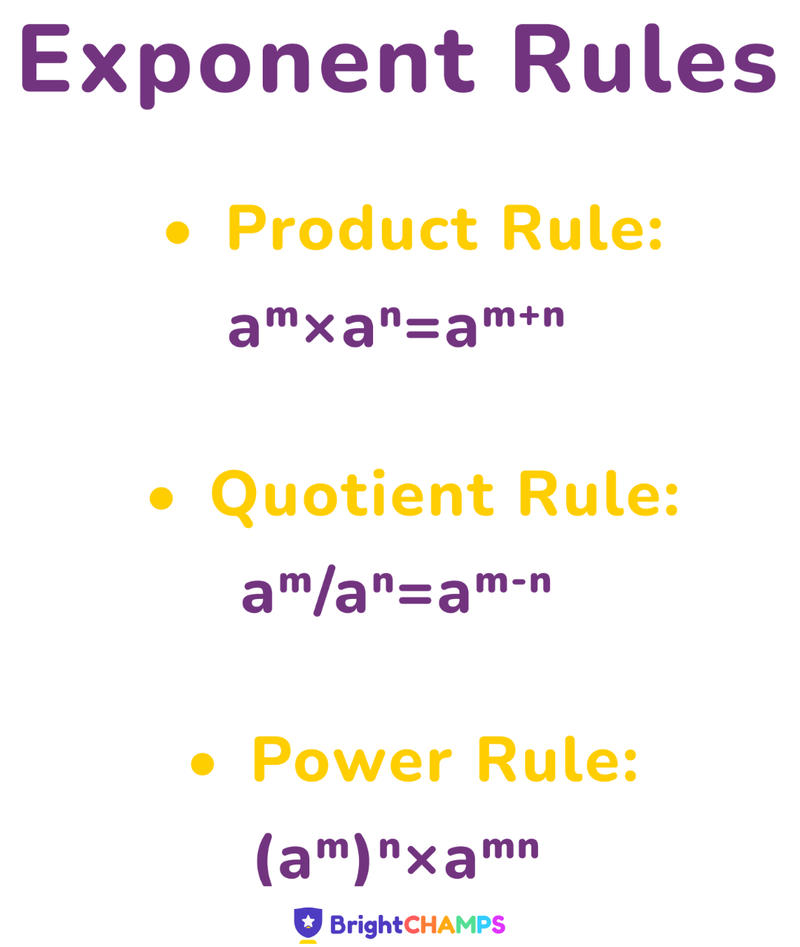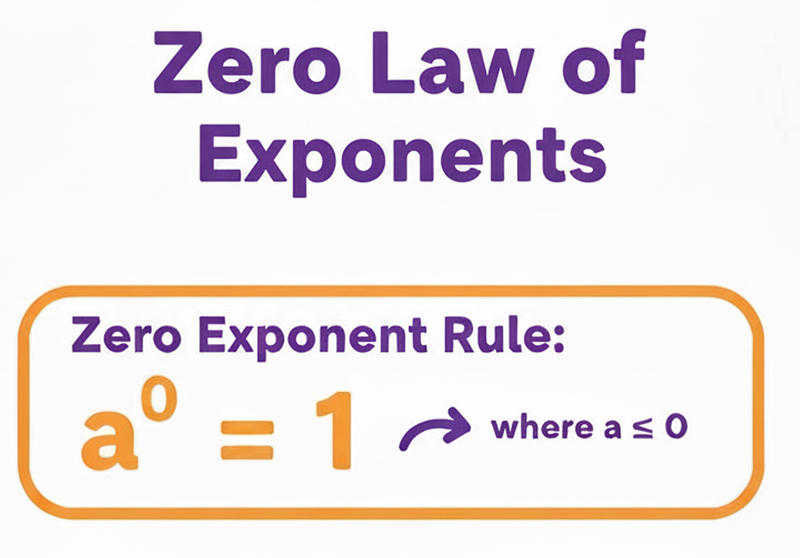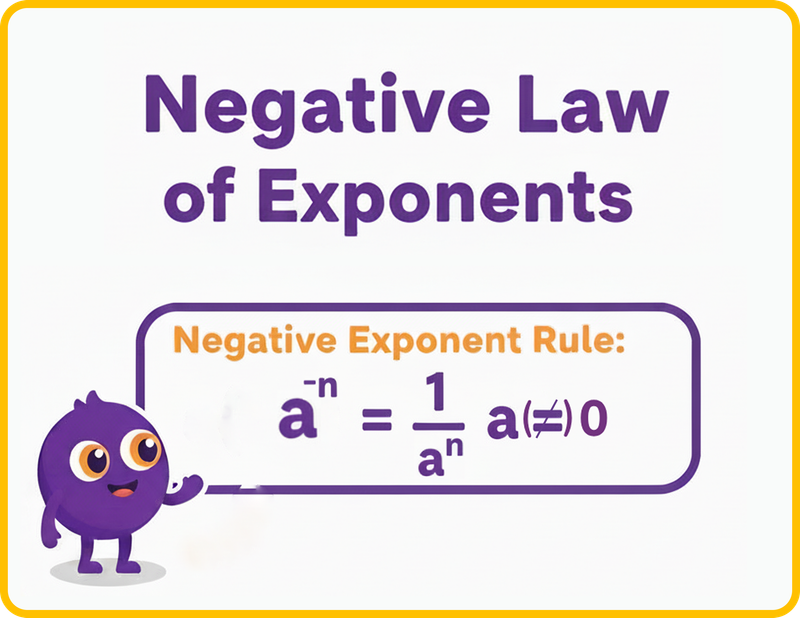Summarize this article:
 254 Learners
254 LearnersLast updated on December 10, 2025
Exponent Rules

Exponents show repeated multiplication of the same number. Here, the base is multiplied by itself as many times as indicated by the exponents. Exponent rules make it easy to simplify expressions involving arithmetic operations on numbers with exponents. In this article, we will learn more about the exponent rules.

What are the Exponent Rules?

An exponent is a number that tells us how many times a base is multiplied by itself. It is written in the form: \({a^{n}}\), where a is the base and n is the exponent. For example, \({{2^{3}} = {2 \times 2 \times 2} = {8}}\). Exponent rules are also known as the laws of exponents. It helps to simplify expressions involving powers. The exponent rules are useful to simplify expressions involving operations like multiplication, division, and raising a power to another power.

What are the Laws of Exponents?
There are different laws of exponents to make the calculations easier. Understanding these rules helps to simplify the exponents. The laws of exponents are:
1. Product of Powers: When you multiply expressions with the same base, add the exponents. If \({a^{m}} \cdot {a^{h}}\) is the expression, then the product will be: \({a^{m}} \cdot {a^{b}} = {a^{m + n}}\)
Example: \({x^{3}} \cdot {x^{2}} = {x^{3+2}} = {x^{5}}\)
2. Quotient of Powers: When you divide expressions with the same base, subtract the exponents, like \({{a}^{m} \over {a^{n}}} = {a^{m - n}}\)as long as \({\alpha = 0}\)
Example: \({{y}^{5} \over {y^{2}}} = {y^{5 - 2}} = {y^{3}}\)
3. Power of a Power: When you raise an exponent to another exponent, multiply them, like
\({(a^{m})^{n}} = {{a}^{m \cdot n}}\)
Example: \({(x^{2})^{4}} = {{x}^{2 \cdot 4}} = {x^{2}}\)
4. Power of a Product: Distribute the exponent to each factor inside the parentheses, like
\({(a b)}^{m} = {a^{m}}{b^{m}}\)
Example: \({(3x)}^{2} = {3^{2}}\cdot {x^{2}} = {9{x^{2}}}\)
5. Power of a Quotient: Distribute the exponent to both the numerator and the denominator,
like \({({a\over b})^n} = {{a}^{n}\over {b}^{n}}\)as long as \(b = 0\)
Example: \({({x\over y})^3} = {{x}^{3}\over {y}^{3}}\)
6. Zero Exponent: Anything (except 0) raised to the 0 power will be 1.
\({a^{0}} = {1} \quad {(\text {if } \, {a \ne 0})} \)
Examples: \({5^{0}} = {1}\)
7. Negative Exponent: A negative exponent means to take the reciprocal, like \({a^{-n}} = {{1} \over {a^{n}}}\) \((\text {if } \alpha = 0)\)
Example: \({{x^{-3}} = {{1}\over {x^{3}}}}\)


What is the Quotient Law of Exponents?
The quotient law of exponent is used to divide expressions that have the same base.
\({{{a^{m}}\over {a^{n}}} = {{a^{m-n}}}}\) as long \({\alpha} = {0}\)
Example: \({{{x^7}\over{x^{3}}} = {x^{7-3}} = {x^{4}}}\)
Explore Our Programs



What is the Zero Law of Exponents?
The zero law of exponents (also called the Zero Exponent Rule) applies when an expression has an exponent of 0. According to this law, any non-zero number raised to the power of 0 is equal to 1.
\({{a^{0}} = {1} }\)(as long as \({\alpha} = 0\))
If you raise any non-zero number to the 0 power, the result will always be 1, regardless of how small or big the number is.
For example, \({5^{0}} = {1} \), \({{25^{0}} = {1}}\).


What is the Negative Law of Exponents?
The negative exponent law is applied when the exponent is negative. According to the negative law of exponent, to make a negative exponent positive, take the reciprocal of the base.
\({{a}^{-n}} = {{1} \over {a^{n}}}, {( {a {\ne} 0})} \)
For example, \({5^{-2}} = {1\over {5^{2}}} = {1\over {25}}\), \({{2^{-3}} \over {3^{-2}}} = {3^{2} \over {2^{3}}} = {{9} \over {8}}\)


What is the Power of a Power Law of Exponents?
The power of a power law, also called the power rule, is used when an expression is raised to another exponent. According to this rule:
\({(a^{m})^{n} = a^{m \cdot n}}\)
This means when multiplying the exponent while keeping the base the same.
For example, \({(x^{2})^{4}} = {x}^{2\cdot4} = {x^{8}}\)

What is the Power of Product Rule of Exponents?
The power of a product rule is used when a product is raised to a power. According to this rule:
\({{(ab)^{n}} = {a^{n}} \cdot {b^{n}}}\)
This means the exponent is applied to each factor inside the parentheses
Example: \({3{x}^{2}} = {{3^{2}} \cdot {x^{2}}} = {9x^{2}}\)

What is the Power of a Quotient Rule of Exponents?
The power of a quotient law is used to simplify expressions where a fraction (quotient) is raised to a power.
\(({{a} \over {b}})^{n} = {{a^{n}} \over {b^{n}}}\) as long as α = 0 and b ≠ 0
When a fraction is raised to an exponent, the power is applied to both the numerator and the denominator.
Example, \(({{2x} \over {3}}) ^{2} = {{(2x)}^{2} \over 3^2} = {{4x}^{2} \over {9}}\)

Fractional Exponents Rule
The fractional exponents rule (also called the rational exponents rule) helps you understand what it means when an exponent is a fraction.
\({a^{\frac{m}{n}} = \left( \sqrt[n]{a} \right)^m = \sqrt[n]{a^m}, \quad \text{where } a \ge {0}} \),
The denominator of the fraction (the bottom number) represent the nth root. The numerator (the top number) represents the power.
Example, \({8^{\frac{2}{3}} = \left( \sqrt[3]{8} \right)^2 = \sqrt[3]{8^2} = 4}\)

Exponent Rules Chart
| Rule Name | Rule | Example |
|
Product of Powers
|
\({{a^{m}} \cdot {a^{n}} = {a^{m+n}}}\) | \({x^{2}} \cdot {x^{3}} = {x^5}\) |
|
Quotient of Powers
|
\({{a^{m}\over {a^{n}}}} = {a^{m-n}}\) | \({{y^{5}}\over y^{2} }= {y^{3}}\) |
|
Power of a Power
|
\({(a^{m})}^{n} = {a}^{m \cdot n} \) | \({(x^{2})^{3} = x^6}\) |
|
Power of a Product
|
\({{(ab)}^{n} = {a^{n}} \cdot {b^{n}}}\) | \({{(a2x)}^{3} = {8x^{3}}}\) |
|
Power of a Quotient
|
\({{({a\over b})} ^ {n} = {{a^{n}}\over {b^{n}}}}\) | \({{({x\over y})} ^ {2} = {{x^{2}}\over {y^{2}}}}\) |
|
Zero Exponent
|
\({{a^{0}} = 1}\), if \(a \ne 0\) | \({7^{0} = 1}\) |
|
Negative Exponent
|
\({{a^{-n}} = {{1}\over {a^{n}}}}\) | \({{x^{-3}} = {{1}\over {x^{3}}}}\) |
|
Fractional Exponents
|
\({a^{\frac{m}{n}} = \left( \sqrt[n]{a} \right)^m = \sqrt[n]{a^m}}\) |
\({27 {2 \over 3}} = {9}\) |

Tips and Tricks to Master Exponent Rules
Exponent rules make working with powers and repeated multiplication much easier. Mastering them helps you simplify complex expressions quickly and accurately. Here are some easy tips and tricks to master exponent rule.
- Check whether the base are same, when multiplying or dividing powers. For example, \({2^{3}} \times {2^{4}} = {2^{3 + 4}} = {2^{7}}\). |
- The negative exponent of any number is the inverse of the number. For example, \(5^{-2} = {1\over {5^{2}}}\).
- Memorize the basic exponent rules but connecting it with the real-life context such as compound interest, population growth, or bacteria doubling.
- Remember that when multiplying power we add the exponent and when dividing, substrate them. For example, \({{a^{3}}} \times {a^{2}} = {a^{3 + 2}} = {a^5} \), \({{a^{5}} \over {a^{2}}} = {a^{5 - 2}} = {a^{3}}\)
- Any number raised to the power of zero is equal to 1. For example \({5^{0}} = 1\)

Common Mistakes in Exponent Rules and How to Avoid Them
Understanding exponent rules is essential in algebra, but it’s easy to slip up without realizing it. This quick guide highlights the most frequent mistakes students makes, like confusing when to add or multiply exponents, misusing negative exponents, or forgetting parentheses, and shows simple tips to avoid them and solve problems accurately.

Real-Life Applications of Exponent Rules
The rules of exponents are used whenever we deal with quantities that grow or shrink rapidly. These rules have many real-life applications in areas such as finance, science, and technology. Some applications are:
- Exponents are used to calculate how your money increases with each compounding period. For example, when you deposit money in a bank or invest it, the amount grows over time due to compound interest.
- Scientists and researchers use exponent rules to predict how large a population will become over time. For example, to understand the growth of bacteria.
- The Richter scale, used to measure earthquake magnitudes, is based on powers of 10. Each increase of one point means the earthquake is 10 times stronger than the previous level.
- In medical treatments such as radiation therapy for cancer, doctors use exponential formulas to determine safe and effective radiation doses for patients.
- Digital storage units like kilobytes (KB), megabytes (MB), and gigabytes (GB) are based on powers of 2. For example, 1 GB equals \(2^{30}\)
bytes, which is over a billion bytes of data.

Solved Examples of Exponent Rules

Problem 1
What is 2 to the 3rd power times 2 to the 2nd power?

\(2^3 \cdot 2^2 = 2^{(3+2)} = 2^5 = 32 \)
Explanation
When multiplying the same bases, add the exponents: \(3 + 2 = 5\).

Problem 2
What is 5 to the 6th power divided by 5 to the 2nd power?

\({{{{5^{6}}\over {5^{2}}} = {5^{(6-2)}} = {5^{4}} = 625}}\)
Explanation
When dividing the same bases, subtract the exponents: \(6 - 2 = 5\)

Problem 3
What is (32)3 raised to the 3rd power?

\({{(32)^{3}} = {3^{(2·3)}} = {3^{6}} = {729}}\)
Explanation
When raising a power to another power, multiply the exponents: \(2 × 3 = 6\).

Problem 4
What is 2x²?

\({(2x)^2 = 2^{2} \cdot {x^{2}} = {4x^{2}}}\)
Explanation
Apply the exponent to both 2 and x: \({{2^{2}} = {4}, {x^{2}} = {x^{2}}}\)

Problem 5
What is (y divided by 3) squared?

\({{({y \over 3})}^{2} = {{y^{2}}\over {3^{2}}} = {{y^{2}}\over {9}}}\)
Explanation
Apply the exponent to both the numerator and the denominator: \({y^{2}}\) and \({{3^{2}} = 9}\).


FAQs of Exponent Rules
1.What is an exponent?
2.What is the product rule?
3.What is the quotient rule?
4.What is the power of a power rule?
5.What is the zero exponent rule?


Jaskaran Singh Saluja
About the Author
Jaskaran Singh Saluja is a math wizard with nearly three years of experience as a math teacher. His expertise is in algebra, so he can make algebra classes interesting by turning tricky equations into simple puzzles.
Fun Fact
: He loves to play the quiz with kids through algebra to make kids love it.

















